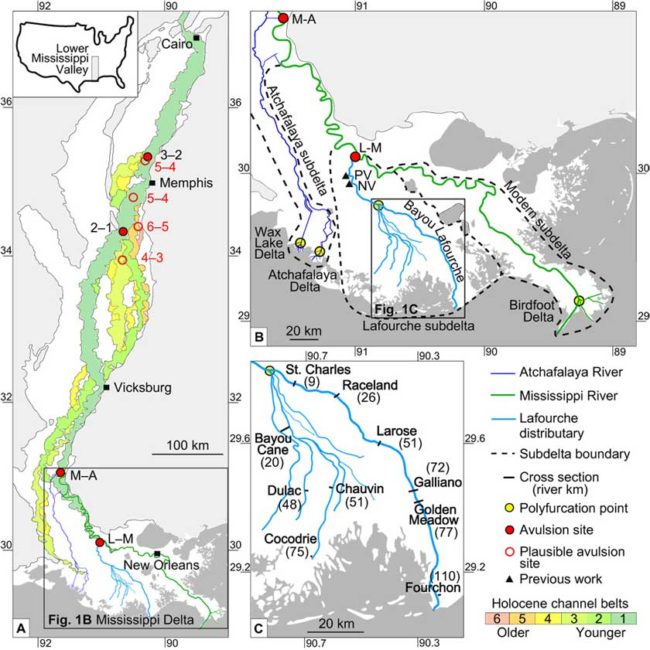In addition to the news about the slowing down of the Ocean Circulation system we also have news that rising seas are causing problems in the Mississippi River Delta.
There is a new study that reveals the scope of the problem. Entitled “Anatomy of Mississippi Delta growth and its implications for coastal restoration” and published within Science Advances, the essence of it is as follows.
As the Mississippi flows into the sea it dumps sediment, and that creates land. To explore this process the researchers collected samples and used them to determine exactly when that sediment was laid down using a technique called “optical dating”. This enables them to work out the precise rate of the grown of the delta. This is what they found …
Progradation rates (100 to 150 m/year) were surprisingly constant, producing 6 to 8 km2 of new land per year. This shows that robust rates of land building were sustained under preindustrial conditions.
Now here is the catch. Due to rising sea levels, we also know the rate at which land is being lost. That rate is 45 km2. Least you missed the point there, if the sediment being deposited grows the delta by 6-8 km2 and sea level rise eats 45 km2 then the result is a rather obvious ongoing consistent net loss, or to quote the study …
Considering recent land loss rates (~45 km2/year) in combination with the global sea-level rise acceleration, net land loss in the modern delta will likely continue regardless of coastal restoration strategies, ultimately producing a deltaic landscape that will be very different from the present one.
To try to grab that rate of loss, if we have a loss of 45 km2 then that is roughly about one football field sized area of land being lost each and every hour.
Why does this matter?
Is this important?
Basically yes. Rather obviously this will impact the costal communities that currently thrive there, and also since the area is a habitat for wildlife then that also will be impacted. Beyond that there is the not so obvious. These wetlands act as a barrier that takes the full force of incoming hurricanes. When such an event strikes, a reduced delta will result in cities such as New Orleans taking an even greater hit.
Is there anything we can do?
There is an ongoing rather ambitious piece of engineering that involves capturing sediment in order to try to rebuild wetlands …
We have the muddy Mississippi and nearly 100-million tons of sediment at our disposal annually,” Reyher said. “The Mid-Barataria Sediment Diversion Project will move sediment and water from the river to feed our starving wetlands. This project will be one of the most ambitious environmental restoration projects ever undertaken by our nation. It will provide protection and, also economic opportunity in our rapidly developing water industry sector.”
The problem, even in the context of this project, is that the numbers don’t add up. Because the rate of loss still exceeds the rate of potential sediment sourced wetland growth.
It is however the only game in play that has any chance of saving anything at all.
The reality of climate change is here today, it is not something that happens in some far and distant future.
Comments
“only part of the Mississippi Delta may be sustainable with rising seas is not a new idea to coastal scientists and restoration planners in Louisiana,” – Andy Nyman, an expert on wetlands at Louisiana State University, who commented on the study but was not involved with it.
“We’re still convinced that these river diversions are basically the only real shot at getting something done in terms of coastal restoration, But you have to be really realistic about what you can expect, and it’s going to be have to be very focused on small and carefully selected parts of the delta. It means very difficult choices are going to have to be made.” – Torbjorn Tornqvist, a Tulane University geologist who was one of the study’s authors
Links
The Press Release is here.

